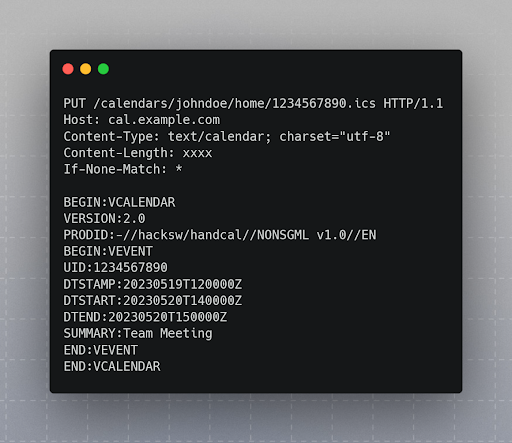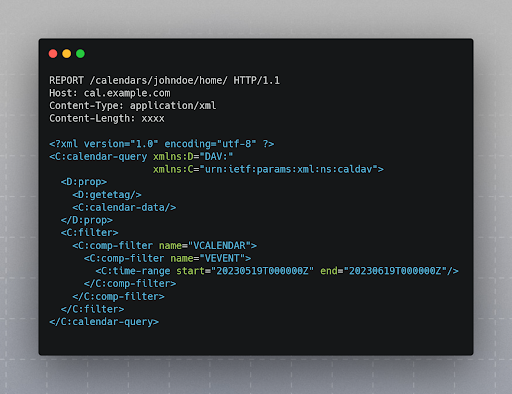Cal.com v4.9.3
Cal.com v4.9.3
Existing customer? Login
Get StartedSupporting the CalDAV protocol requires a thorough understanding of the nuances and specifics of this Internet standard. Implementing is not easy; we would see every other scheduling platform supporting this if it were. However, we at Cal.com enjoy a challenge. CalDAV's integration is crucial for Cal.com as it aligns with our vision of providing a transparent, flexible, and user-friendly scheduling infrastructure that can interact seamlessly with other calendar systems, promoting a more connected and efficient scheduling environment for everyone.
We hope this blog clarifies the procedure and helps readers understand why having a reliable CalDAV integration is so tricky. Please join us as we navigate the complex labyrinth of CalDAV integration support for Cal.com.
A client can access scheduling data on a distant server using the Internet Standard Protocol known as CalDAV, short for Calendar Extensions to WebDAV. It enables a client to easily add, read, edit, and delete calendar events stored on a server. In essence, it allows users to share and manage calendar information online. It is one of the most requested integrations at Cal.com and for a good reason. There are very few scheduling solutions supporting CalDAV.
This Internet standard for sharing calendar data is based on the iCalendar format, which is widely used. With the help of this standard, clients can easily update or retrieve data from the server. The fact that all of these actions can be carried out on diverse platforms and devices is convenient and valuable. This implies that your scheduling information can be synchronized whether you're using a desktop computer, smartphone, or tablet with differing operating systems to access it.
Let's say we want to create a new event in our calendar using CalDAV. We'd use an HTTP PUT request, which might look something like this:

In this request, we're creating an event with a unique identifier (UID) of 1234567890; that's a team meeting scheduled to start at 2 PM and end at 3 PM on May 20, 2023.
To retrieve a list of events from the calendar, use a REPORT request with a time-range filter. It might look something like this:

In this REPORT request, we're asking for all events (VEVENT) within a specific date range from May 19, 2023, to June 19, 2023. The server would return an XML document with the data for each event in that date range.
This should give you a glimpse into the mechanics of CalDAV. It's a sophisticated protocol that, when implemented correctly, facilitates smooth and reliable calendar management. At Cal.com, we are en route to enabling our support of the iCalendar 2.0 format. Employing this protocol ensures our users enjoy a superior scheduling experience.
Implementing a CalDAV supporting system comes with its share of technical intricacies. It requires a deep understanding of various server requirements, complex HTTP and XML structures, and advanced scheduling concepts. Let's delve into these aspects briefly:
Different CalDAV servers might have distinct nuances in interpreting and implementing the standard. Understanding these variations is crucial in ensuring a seamless experience for users when integrating with multiple calendar services. It's about diving deep into each server's documentation and getting your hands dirty with testing and debugging.
CalDAV is built on top of the HTTP protocol and uses XML for data representation. The complex structure of HTTP requests/responses and XML data manipulation can pose a challenge. For instance, creating a proper REPORT request to fetch specific events or handling multi-status responses requires a robust understanding of these technologies.
Different servers may choose to implement certain optional features of the CalDAV specification or interpret the 'MUST', 'SHOULD', and 'MAY' directives in the specification differently. For example, some servers may choose to implement support for managed attachments, while others might not.
Implementing time zone support is a vital yet challenging aspect of CalDAV. As Cal.com aims to serve users worldwide, the system must accurately account for a myriad of global time zones.

In addition, handling recurring events is another complex feature. CalDAV relies on the iCalendar format for data representation, which includes a detailed yet intricate specification for recurring events. Correctly parsing and interpreting these rules is crucial for maintaining consistent calendar data.
Regarding timezone information, there are several ways it can be represented within the iCalendar format, which CalDAV relies on. Here are a few examples:
Embedding VTIMEZONE components: iCalendar allows the inclusion of VTIMEZONE components to define the timezone used in the calendar object.

This example defines the "America/Los_Angeles" timezone with its daylight and standard time components. This VTIMEZONE information can be referred to within VEVENT components using the TZID property parameter.
UTC or "Zulu" time: iCalendar allows date-time values to be specified directly in Coordinated Universal Time (UTC), also known as "Zulu" time, by appending a "Z" to the end of the timestamp.
In the iCalendar format, the DTSTART property, which specifies the start time of an event, can include a TZID property parameter to specify the time zone. How different servers and clients handle and interpret the TZID parameter can vary, leading to potential discrepancies or interoperability issues.
While the iCalendar format allows for several ways to represent time zones, some implementations might only support some of these methods equally well. Some might handle UTC time and floating time perfectly well but may have trouble interpreting VTIMEZONE components.
Recurring events are a complex aspect of the iCalendar format and, thus, of the CalDAV standard. Different platforms might have diverse ways of interpreting recurring rules, leading to potential discrepancies in how such events are handled and displayed. Some CalDAV service providers choose to handle recurring rules (RRULE) internally, which means we need to confirm if they handle the request of the EXPAND property well. If they don’t, the requests might fail silently.
Addressing another intricate piece of the iCalendar and CalDAV puzzle is crucial: all-day events. As simple as they seem, all-day events introduce another layer of complexity regarding time zone handling.
An all-day event, such as a birthday or a public holiday, is typically considered to occupy the entire day, regardless of the time zone. The tricky part arises when we consider that an 'entire day' can start and end at different times in different time zones.
In the iCalendar format, all-day events are represented as date values without a time component and also without a time zone. For example:

This format does not specify a time zone for the event, so it's up to the system that is interpreting the event to determine how it should be displayed and handled. This can become tricky when it comes to calculating free/busy data on an hourly basis.
For example, if a user in San Francisco (PDT, UTC-7) schedules an all-day event, and another user in New York (EDT, UTC-4) checks their free/busy status, there could be a discrepancy. When does the 'entire day' start and end for each user? Is there a 3-hour period when the San Francisco user is still busy with the all-day event, but the New York user is already free?
At Cal.com, we're working on intelligent ways to handle this challenge. In this case, we adjust the display based on the event organizer's time zone in our system. By adopting this approach, we aim to ensure that all-day events are handled accurately per the Host’s availability, regardless of where the bookers are located.
In implementing the iCalendar standard, many CalDAV service providers opt for their custom parameters and internal handling of certain aspects. A typical case illustrating this scenario revolves around the handling of recurring events, specifically the EXPAND property, by certain calendar services. For example, Zoho prefers to handle it internally and instead fails silently if we request with the EXPAND property as true. This caused a lot of pain when debugging the exact cause of the Calendar Objects not being returned by Zoho even though the return header status was 200.
All of this underscores the importance and challenges of careful and rigorous testing in implementing a robust CalDAV solution like the one we're building at Cal.com.
The phrase 'One size fits all' is often used to suggest that a single solution or system can meet the needs of all users or scenarios. However, in the context of CalDAV implementation, this concept becomes more of a fallacy than a feasible approach. Here's why:
When discussing CalDAV implementation, we deal with a diverse ecosystem of calendar servers, clients, and user needs. Different servers might interpret the CalDAV and iCalendar standards slightly differently, and different clients might have unique features or constraints. Additionally, user needs can vary greatly, from someone who just wants to keep track of a few personal appointments to a multinational corporation that needs to coordinate thousands of schedules across various time zones.
Creating a 'one size fits all' solution in this context would mean developing a CalDAV implementation that supports all standards, is compatible with every server, works flawlessly on every client, and perfectly fits the users needs. This is a tall order and arguably, unrealistic.
Instead of trying to create a 'one size fits all' solution at Cal.com, we focus on developing a flexible and adaptable CalDAV implementation that satisfies a specific standard. We embrace the diversity in the CalDAV ecosystem and strive to provide a service that works well across a wide range of servers and clients while offering a set of core features that meet the needs of most users. We are on our way to supporting iCalendar 2.0 fully, making sure our system can adapt and grow to support all providers who follow the iCalendar 2.0 standard in their CalDAV implementation. This includes supporting the flexibilities that iCalendar 2.0 offers with varying interpretations and implementations.
Facing too many issues since the inception of this integration almost led us to consider closing it down, but we had to give it one final push. Looking back, it’s scary to realize how close it was to being shut down entirely.
Now that we’re slowly getting there and making the CalDAV integration more stable, we plan on improving the user experience. There are a lot of talks and discussions between the engineering team exploring the improvements to CalDAV as a whole, from reliability to providing more comprehensive integration support to the end-user experience in managing a CalDAV integration with Cal.com. We’re committed to making it a reliable and stable integration.
Author Bio: Syed Ali Shahbaz currently holds the position of Developer Relations Engineer at Cal.com. With a rich tapestry of experiences, Ali co-founded the Log Doctor app and was previously at the helm of Timecrypt.app, a groundbreaking Blockchain-based time management tool. He masterminded its entire development, from design to deployment, in a little over a year.
An alumnus of both the University of St Andrews and King’s College London, Ali’s academic credentials speak volumes. He has garnered MSc degrees in Artificial Intelligence and Robotics from these esteemed institutions, equipping him with profound insights into realms like AI, Machine Learning, and Robotics.
Cal.com v4.9.3
Checkout product updates, performance improvements, new features, and code changes in Cal.com v4.9.4